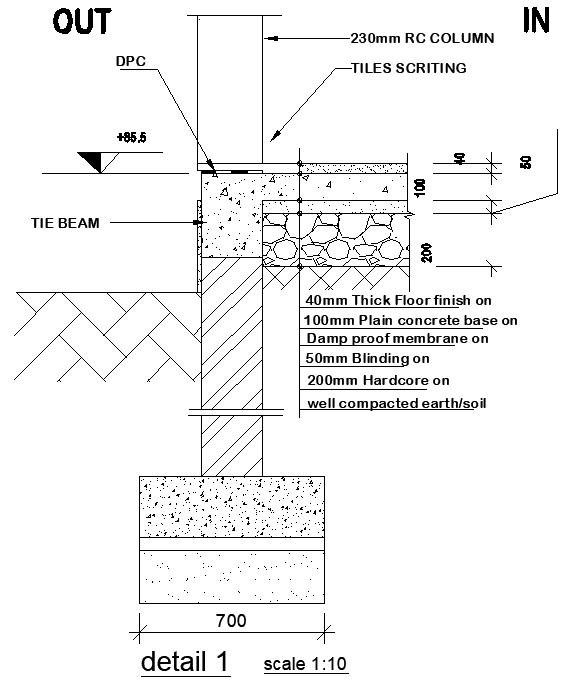A beam tie is a beam employed in the top levels of a building to reinforce the connection between columns, rafters, or other structural parts. They act as a strap beam, bearing all the loads when an uneven vertical portion of the foundation is present.
Tie beams are often inserted at the plinth, floor level, and roof truss. They cannot support vertical weight, such as walls or other structures. Tie beams can be utilised as a tie element in addition to their primary purpose to stop differential settlement between footings that could happen depending on the strata.
See also: Lintel beam: Meaning, types and purpose
Beam tie: Bar bending schedule
- Determine the quantities of reinforcement needed for the building using the bar bending schedule. For information gathering on the tie beam/strap beam reinforcement in the substructure, a bar bending schedule for footings is essential.
- A beam that joins the two footings in the substructure is a beam tie. It should be set up if the two footings stay in the same line.
- Similar to a beam tie, a strap beam, also known as an inclined beam, fastens two footings at a certain angle. If two foundations remain at different levels, a strap beam is added.
- Particularly near pile caps and shallow foundations is the tie beam/strap beam. Their primary goal is to get all pile caps or shallow foundations to nearly the same height.
Beam tie: Designing
Beam ties connect two columns and prevent movement in both directions. Any level may have tie beams. They are known as plinth beams if they are at the plinth level, where they also aid in soil retention for the inside of the house and provide support for walls.
The degree of differential settling of the foundation chosen for the task at hand will determine the tie beam’s design. The members of the beam-column junction receive this moment according to their degree of flexural stiffness if the delta is the differential settlement.

Source: Pinterest
Beam tie: Significance
Constructors must remember that beam tie will be formed of regular concrete and will have an axial load to construct one that can withstand the vertical and horizontal reactions of the Frame.
This axial load is excellent for axial compression-like axial column capacity because it may be seen as either a compression or tension load. The function of the concrete is to protect the steel and take the stress of condensation since it is a tension member rather than a compression member.
Beam tie: Benefits
- Beam ties serve as length breakers for columns when the floor is abnormally high and does not carry any floor loads.
- In the event of differential settlement, they act as grade beams to transfer vertical loads through moment and shear.
- They join pile clips or the footings of columns.
- The compression they carry is axial.
- They stop thin longitudinal columns under extreme stress from bowing outward.
- While concrete is being poured, they keep longitudinal bars in place. They shift the load from the rafter to the column.
- During earthquake occurrences, they maintain the spread footing in their locations. To support interior or exterior walls, they act as strip footings.
- Over a pile foundation, they act as grade beams to connect the pile caps and support the structure above.
Beam tie: Reinforcement
Around the world, reinforced concrete is frequently used in construction. The loads are transferred to the foundation by columns from the beams and slabs. Columns in mega constructions like long-span structures and tall buildings support high compressive forces. Because concrete’s strength and flexibility are restricted, overloading and natural calamities like earthquakes and fires can cause damage to columns.
For RC columns, both lateral and longitudinal reinforcements are necessary. The confining volume is stressed as the concrete core is compressed radially in a horizontal direction.

Source: Pinterest
Beam tie: Calculation
- Determine the tie beam’s overall length and the total dead and live load according to the section drawing provided.
- Determine the maximum bending moment and shear force that the beam can withstand based on the load.
- 1 m of steel weighs d2/162 kg (where d is the diameter). This formula makes it possible to determine the weight of reinforcement needed based on the required area.
FAQs
Is a Beam tie essential for building a foundation?
Beam ties are frequently required when a column is taller than 12 to 15 feet. However, there is a lot of design flexibility. They are typically not required at heights under 12 feet. Weight-bearing primary and secondary beams support the floor.
Which is the best cement for beam tie?
The best cement is Portland Pozzolana Cement (PPC), which hydrates gradually and provides a high final strength.
| Got any questions or point of view on our article? We would love to hear from you.
Write to our Editor-in-Chief Jhumur Ghosh at [email protected] |
Housing News Desk is the news desk of leading online real estate portal, Housing.com. Housing News Desk focuses on a variety of topics such as real estate laws, taxes, current news, property trends, home loans, rentals, décor, green homes, home improvement, etc. The main objective of the news desk, is to cover the real estate sector from the perspective of providing information that is useful to the end-user.
Facebook: https://www.facebook.com/housing.com/
Twitter: https://twitter.com/Housing
Email: [email protected]











